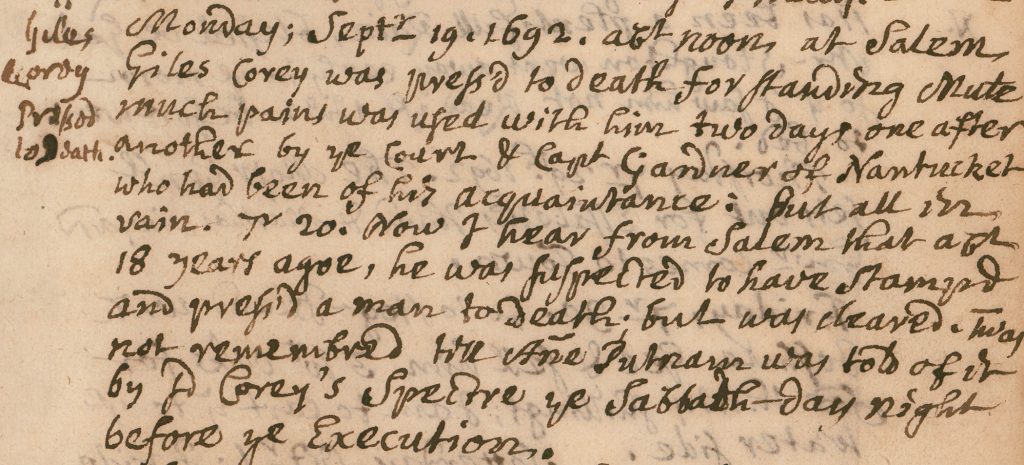By Heather Rockwood, Communications Associate
Autumn is my favorite time of year; celebrating Halloween and all things gruesome, haunted, and scary. One of my favorite, and kind of gross, stories to tell people, especially in September on its anniversary, is the tale of Giles Corey, pressed to death during the Salem Witchcraft Trials of 1692.
In 1692, Giles Corey was a successful farmer in Salem Village, the current location of Danvers, Mass., when a group of girls and young women started accusing locals of bewitching them with specters, pinches, and disease. Disliked personalities and large properties played a large part in who was accused of witchcraft during the trials. Giles was a criminal and was not well-liked. In 1676, he was tried for the death of Isaac Goodale, an indentured servant, whom he beat with a stick for stealing some apples. He was found guilty, but was only fined since corporal punishment towards indentured servants was legal. Many community members witnessed the beating and testified against him. Giles was also accused of stealing several times and had such a reputation that when John Proctor’s house burned down a few years previous, he assumed Giles had burned it! Giles’s wife, Martha, also had a mixed reputation. She was adulterous during her previous marriage but when she and Giles married, the community remarked a distinct change for the good in them both. However, their loud bickering was witnessed often.
Giles attended some of the first trials that took place in a tavern, and Martha was quickly accused of witchcraft. At first he testified against his wife, believing the accusations, but then changed his mind and tried to recant his words. Abigail Hobbs, another accused of witchcraft, named Giles Corey as a wizard close in time to when he testified against his wife. Martha denied the accusations but Giles would not plead guilty or not guilty. Giles Corey may not a have been a good person but he was smart. He knew that if he plead and let the trial happen, his estate would be taken away from his family after his execution. To save his children’s inheritance, he would not plead. According to the law at the time, those who did not plead could not be tried. To try to get the accused to plead, the legal remedy was “peine forte et dure,” translating to “strong and hard pain.” It became the name for the torture of pressing.
WARNING: below this image is graphic language explaining the mechanics of torture.

In the MHS collection is the diary of Samuel Sewall, one of the judges of the Salem Witchcraft Trials. Sewall kept a journal from 1673 until a few months before his death in 1730. His entry for 19 September 1692 reads:
“Monday; Sept-19th 1692. Abt noon, at Salem, Giles Corey was pressed to death for standing mute Much pains was used with him two days one after another by ye court & Capt. Gardner of Nantucket who had been his acquaintance: but all in vain. 20 Now I hear from Salem that abt 18 years agoe, he was suspected to have stamped and pressed a man to Death. But was cleared. twas not remembered till Ann Putnam was told of it by G Corey’s Specter ye Sabbath-Day night before ye Execution.”
After he would not plead, Giles was asked to strip naked and lay down, face up, on the ground. A wooden board was then placed on top of him, and on top of the board, one by one, Sheriff George Corwin placed large rocks. After two days of this torture, through which Giles had remained silent, never crying out, he was asked to plead. Giles did not want his property to be taken, so he never plead either way. On the third day 19 September 1692 he died from being pressed to death. His last words were “more weight.”
Giles plan did work, his estate passed to his two sons, however Sherriff Corwin successfully extorted money from Giles daughter who later pressed posthumous charges against the Sherriff for his crime. Sherriff Corwin died of a heart attack in 1696, and every Sherriff after him died or resigned of some kind of blood ailment until 1991 when the Sherriff’s office moved from Salem to Middleton, Mass. Some witnesses say that Giles Corey did not remain silent and had cursed the title of Sherriff: “Damn you, I curse you and Salem!” However, it is mostly agreed upon that “more weight” were his last words.
Giles Corey’s case is the only of its kind in New England, although other pressings happened in England. Martha was hung as a witch three days later. The gruesome and public torture of Giles Corey changed some of the minds of the community about supporting the witch trials.

